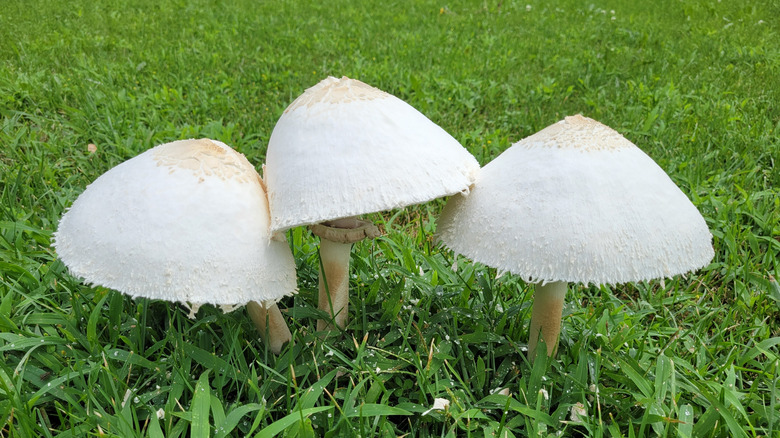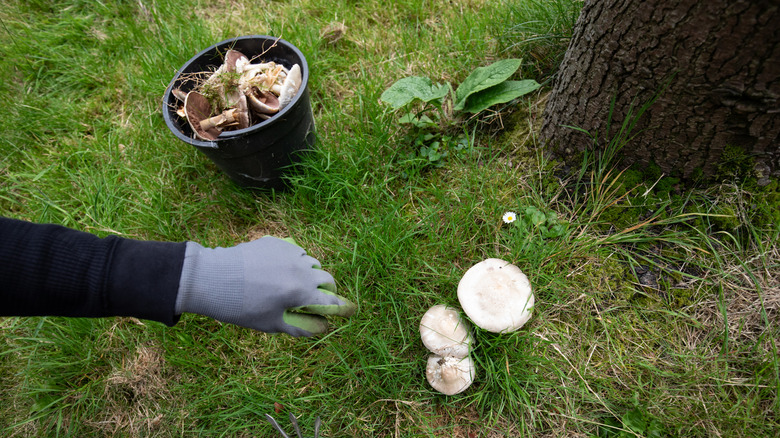What It Means When Mushrooms Pop Up In Your Yard (And If You Should Worry)
Learning how to care for your lawn takes time and effort. This is particularly true if you've just moved on to a new property or you're planning to grow a new lawn from seed. It's certainly worth the work, however, as regular maintenance will yield a beautiful and attractive lawn. Plus, it will create the perfect space for picnics and outdoor gatherings while enhancing your curb appeal.
But even after you've tended to your lawn, it's possible to find mushrooms growing in your grass. This might include Russula and Chlorophyllum molybdites varieties, though there are many types of mushrooms that can grow in lawns. Understandably, this can be a cause for concern, as the unwanted visitors often appear without warning. You might also worry about kids and pets coming into contact with mysterious mushrooms. Try not to panic, though! Lawn mushrooms are relatively common, and they don't always indicate a problem. By learning why and how the mushrooms grow, you can prepare for their appearance and be ready to remove them, if needed.
Why mushrooms grow on lawns
First, a quick biology lesson. Mushrooms are fungi, which are different from plants. The part that you see (i.e., the cap and stem that grow above ground) is the reproductive part of the mushroom, known as the fruiting structure. This part makes spores that spread, germinate, and grow into new mushrooms. Fungi also naturally live in soil, meaning they're already present in your lawn, ready to grow under the right conditions.
Now, here's why mushrooms might appear on your lawn. If you have a lot of organic material in your yard, it will eventually decay and provide food for mushrooms, prompting them to grow fruiting bodies. Examples include grass clippings, compost, or even animal waste, including those from your four-legged family members. Likewise, if your lawn is very wet from overwatering or heavy rainfall, the extra moisture can make organic matter decay even faster, triggering the growth of mushrooms. Fungi also thrive in humid and hot environments, so they might appear more often in the summer months.
How to prevent and remove lawn mushrooms
The good news: Lawn mushrooms aren't dangerous or harmful unless ingested, and they typically go away as quickly as they showed up. But if you despise their appearance or want to prevent kids or pets from getting too close, there are things you can do to limit their growth. Start by promptly removing organic matter, like old plants or grass clippings, before it starts to decay. It's also a good idea to clean up animal waste immediately. Finally, avoid overwatering your lawn, as mushrooms love moisture.
Even if you minimize the risk factors for mushroom growth, the sneaky toadstools can still pop up. If this happens, you can try to kill mushrooms with vinegar, an all-natural fungicide. However, keep in mind that fungicides in general can kill beneficial organisms in your soil, so use this method with caution. It's also a good idea to avoid mowing them over. This will actually spread the spores around your lawn, resulting in even more mushrooms — it's one of those unknown common lawn mowing mistakes to avoid at all costs. Instead, use a trowel or shovel to remove the mushrooms, then place them in a plastic bag or bucket before throwing them away; this will help minimize the spread of spores. Be sure to wear gloves to protect your hands, too. With these tips in your arsenal, you'll be able to stop the unwelcomed guests from taking over your lawn.


